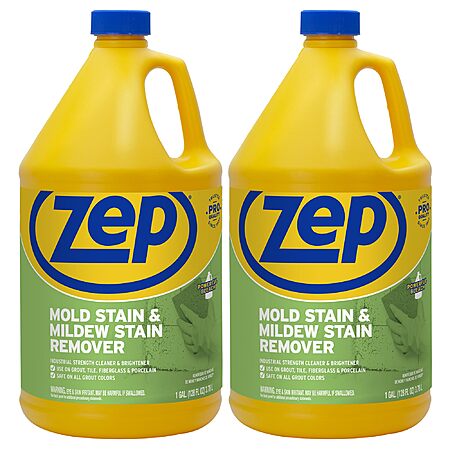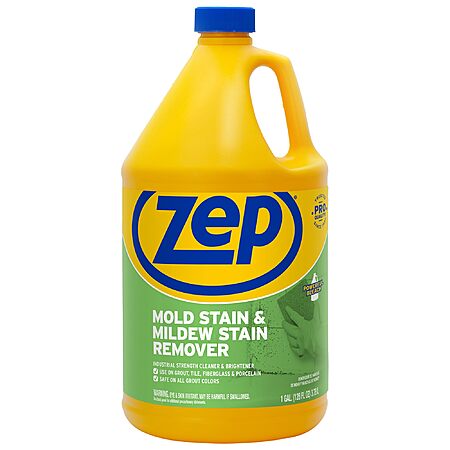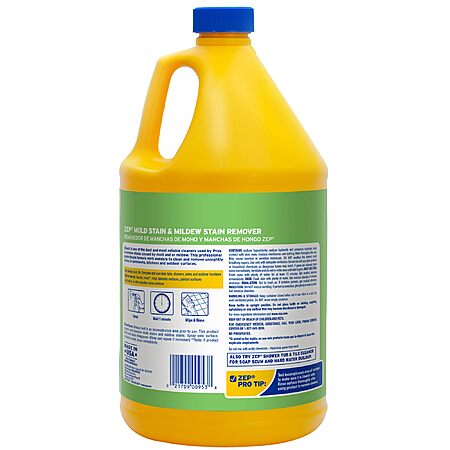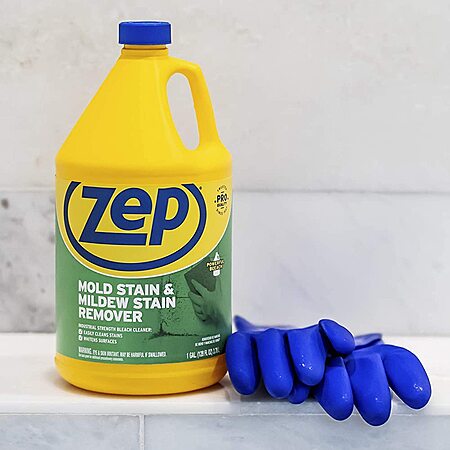forum threadbabgaly | Staff posted Feb 13, 2025 04:10 AM
Item 1 of 4
Item 1 of 4
forum threadbabgaly | Staff posted Feb 13, 2025 04:10 AM
2-Count 1-Gallon Zep Mold Stain and Mildew Stain Remover $15.98 + Free Shipping
$16
$30
46% offAmazon
Get Deal at AmazonGood Deal
Bad Deal
Save
Share




Leave a Comment
15 Comments
Sign up for a Slickdeals account to remove this ad.
Our community has rated this post as helpful. If you agree, why not thank Dr. J
https://imgcdn.mckesson
1-5% sodium hypochlorite. Most good bleach (not watered down dollar store) is more like 5-10%.
https://www.thecloroxco
I like Zep products, but I also like saving money, and many of these types of cleaners are just the same handful of basic chemicals that you can find much cheaper elsewhere.;
This deal is basically paying $16 for 1 gallon of Clorox bleach and diluting it 50%, but my bet is 1 gallon of clorox doesn't cost $16 at the store.
I have been battling a mold spot in the bathroom and been trying to see which of the two is better, but so far, they both need daily application to keep the spot from growing. I've liked vinegar for that purpose, since I also have a little one in the house and prefer the more "natural" aspect of using vinegar.
Shahhere
Shahhere
I've been using pool chlorine for years. Typically can find it cheaper than bleach in season and it's usually closer to 12-15%, or maybe +50% concentration on Clorox meaning you can dilute it more.
Sign up for a Slickdeals account to remove this ad.
And it's definitely the ventilation. It's a crappy old apartment exhaust fan and there isn't much airflow from anywhere.
Bleach does, in fact, kill mold. Mold is killed by acids and strong bases. Also, oxidizers kill mold. Bleach, like hydrogen peroxide, is an oxidizer and will kill mold organisms and spores - as do most oxidizers. HOWEVER, bleach does not soak into porous materials (such as drywall) very well. Therefore, bleach mainly kills the surface mold, while leaving most of the imbedded mold. This means the mold will grow back. Bleach is excellent at killing mold on non-porous surfaces, like tile, but if you are going to use it to kill mold on porous materials, like drywall, you need to use something in addition to the bleach that WILL kill the imbedded mold, preventing it from coming back again. This is why using bleach to kill mold is no longer recommended for restoration work.
Alternatively, you can also use vinegar to kill mold. Acids are generally more effective at killing mold than bases, and of the acids, vinegar is the safest acid you can use to kill mold. Also, some people say you can mix the vinegar with baking soda to make it stronger - no, you can't. Mixing vinegar and baking soda neutralizes the acid in the vinegar; the acidity is what kills the mold, so that is just silly. To use vinegar to kill mold, mix equal parts vinegar and (preferably distilled) water. It doesn't matter if the water is hot or cold. Or, if you do want to make something stronger, mixing distilled vinegar (acetic acid 5% acidity) with hydrogen peroxide is much more effective than just plain old vinegar, but is damaging to skin and eyes . If you use this mix, make it up fresh and use immediately.
Another oxidizer (other than bleach or hydrogen peroxide) you could use is Borax. Borax is a basic oxidizer that is natural and safe for the environment, but generally works best in hot water.
No matter how you are killing mold, please, please, please remember to wear gloves and a mask (preferably one with a HEPA filter). Certain molds, like black mold, produce mycotoxins, which are damaging to neurological pathways, and all mold produce spores, which can cause a variety of health problems if ingested and/or inhaled. Any harsh chemicals used to kill the mold could also cause potential health problems. Most of the time mold exposure goes undiagnosed and untreated or mistreated because it can cause a variety of symptoms, many of which may seem unrelated to one another. Certain people will also have worse reactions than others so one person may have little-to-no reaction to mold exposure, while another develops hives, bloating, extreme fatigue, and a respiratory infection."
"Stop being lazy" is what I said to myself because the time it takes to chop it out after it's dead and wrap it up, I'm just reinstall pieces, tape and paint is well spent for peace of mind and something you can tell clients if you're a property manager.
Chop it out about a foot away from the mall, find some Sheetrock the same thickness. Cut it to fit. Joint compound, tape. Primer with Samantha mold chemical mixed in. And then paint the whole wall like nothing ever happened.
In the US we have this whole industry of certified mold people that want to turn it into the Kennedy space center type project and when you're done paying them you might as well just kill the mold, rip out the sheetrock, wrap it up like you're handling hazmat with the right filter on your face, garbage and gloves, and replace it. Becomes a drywall job any painter can do."
Sign up for a Slickdeals account to remove this ad.
Leave a Comment